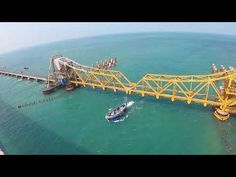The New Pamban Bridge in Tamil Nadu: Strategic and Economic Significance
The Pamban Bridge, also known as the Rameswaram Bridge, is an iconic structure that connects the Pamban Island to the mainland of Tamil Nadu, facilitating crucial transportation and trade in the region. The original bridge, built in 1914, had long been an essential link for travelers and goods moving between the island of Rameswaram and the mainland. However, with increasing traffic, both for passengers and freight, the need for an upgraded and modernized bridge became apparent. In this context, the new Pamban Bridge has become a landmark project in terms of its strategic and economic significance.
Strategic Importance of the New Pamban Bridge
The new Pamban Bridge is strategically vital, not only for Tamil Nadu but for India’s broader connectivity and security framework. Located at the southern tip of India, the bridge connects the Pamban Island (Rameswaram) to the mainland, linking important cities like Madurai with Rameswaram. This geographical positioning makes it essential for the transportation of goods, particularly those related to the fishing and tourism industries that dominate the region.
Moreover, the bridge has immense significance for defense logistics. Rameswaram Island is in close proximity to Sri Lanka, and the area is of strategic importance in terms of national security. The enhanced infrastructure, provided by the new bridge, allows for the smooth movement of defense equipment and personnel to the southern borders of the country. The modernized bridge is also designed to be more resilient in terms of defense preparedness, enabling quicker access in times of need.
Economic Impact and Enhanced Connectivity
The new Pamban Bridge is set to revolutionize transportation and trade in Tamil Nadu. The original bridge was prone to wear and tear, and its capacity was often insufficient to handle the growing traffic, leading to delays and inefficiencies. The new bridge is expected to improve the speed and efficiency of travel for both passengers and goods, significantly reducing transit time between Rameswaram and the mainland.
This improvement in connectivity is likely to have a positive economic impact in several key areas:
- Boost to Tourism: Rameswaram, famous for its religious and cultural significance, is a major pilgrimage destination. The improved infrastructure will make it easier for tourists to access the region, leading to an increase in tourism-related revenue for the local economy. As more tourists visit the area, there will be a higher demand for hospitality, transport, and retail services, contributing to the growth of local businesses.
- Agriculture and Fishing Industries: The southern coast of Tamil Nadu has a thriving fishing industry. The new bridge will facilitate better and quicker transportation of fish and other agricultural produce to markets across the state and beyond. This increased efficiency can boost the incomes of local fishermen and farmers, while also helping meet the demand for these products in urban centers.
- Industrial Growth: The enhanced connectivity brought about by the new Pamban Bridge can facilitate industrial growth in the region. With quicker access to ports and markets, manufacturers and exporters in Tamil Nadu will benefit from lower transportation costs, potentially increasing the competitiveness of local industries.
- Regional Integration: The bridge will contribute to the broader goal of regional integration, connecting smaller towns and cities to the larger economic hubs of Tamil Nadu. Improved transportation infrastructure can lead to more balanced economic development, helping to reduce regional disparities and bringing economic benefits to rural areas.
Environmental and Technological Considerations
The construction of the new Pamban Bridge incorporates advanced engineering and environmental considerations. Designed with state-of-the-art materials and technology, the bridge is built to withstand harsh weather conditions, such as the tropical storms that are common in this coastal region. The modern structure is also designed to accommodate larger ships, ensuring that maritime traffic remains unhindered while improving the flow of road traffic.
The bridge’s design incorporates sustainability features, such as reduced carbon footprints during construction, and efficient transportation of goods and services that minimizes fuel consumption and emissions. This makes the bridge a forward-looking project, in line with India’s efforts to combine infrastructure development with environmental stewardship.
Conclusion
The new Pamban Bridge in Tamil Nadu is a critical infrastructure project with both strategic and economic significance. By improving connectivity, it will enhance the region’s transportation network, benefiting industries such as tourism, agriculture, fishing, and manufacturing. Additionally, it will play a crucial role in national defense and regional integration, strengthening India’s southern borders. As Tamil Nadu continues to grow economically, the new Pamban Bridge will undoubtedly be a key enabler of this progress, ensuring that the region remains connected, competitive, and resilient for years to come.

